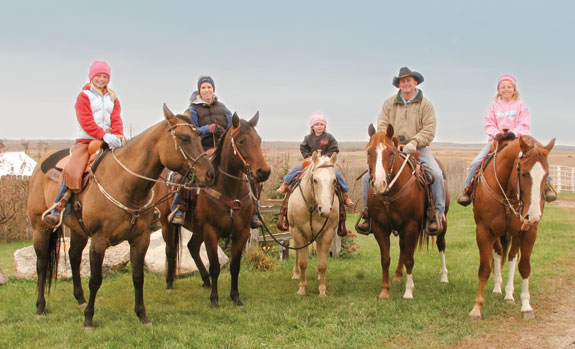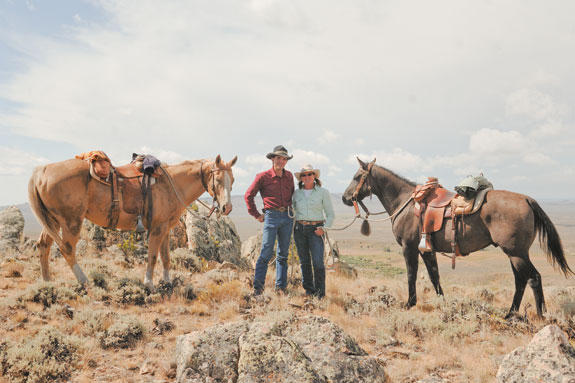But the Internet has added a new dimension to the “communication” realm, making it easier to keep folks informed around the clock.
Traditional communication forms are now supplemented with monthly, weekly or even daily posts to blogs, Twitter and Facebook formats.
These new-age social networking tools allow cattle producers to instantaneously showcase their show and sale cattle, let others know what is happening on their farm or ranch and to connect with others in and outside of the industry.

Cattle producers on Facebook
Kim Coudron was an early pioneer in the effort to use social media for her family’s purebred Charolais operation (www.CoudronCharolais.com) near Monticello, Minnesota. Coudron established a Facebook page for the ranch in early 2009.
Initially, she says it was a way to spotlight juniors who had purchased show cattle from the Coudron herd. That progressed into posting show results, sale information, and even sharing beef advocacy comments.
Coudron likes the Facebook format because it allows information to be added easily with no cost – whereas updating a website can be time-consuming and expensive if you have to hire the work done.
Coudron has found her social media efforts to be hugely successful. She reports that an ad she posted in January 2011 for one of their sale cattle received 1,345 page views.
To others interested in creating a Facebook presence, Coudron says the most important piece of advice is to post new information at least weekly. “You have to update it. The generation using Facebook wants new information.”
And build a relationship with the comments you share. Coudron says, “I view our Facebook page not only as a way to spread the word about Coudron Charolais, but also as an opportunity to share who we are and what’s important to us in the industry.”
Troy and Sara Vollmer of Wing, North Dakota, created a Facebook presence in early 2010 to promote their seedstock operation, Vollmer Angus Ranch (www.VollmerAngus.com).
Sara says she aims to post new comments and photos giving short highlights of what is currently happening at the ranch.
As their annual sale approaches, she will post information several times during the week such as reminders about the sale date and time, sire highlights, links to their catalog on their website and photos of the sale offering.
Of her online efforts, Sara says, “Facebook is just one more way to create awareness of our program among potential customers. It takes very little time and effort, and it is free, so that is a huge plus.”
Sara reports that they do not get a lot of comments posted to their Facebook page, but they have noticed people e-mailing them from their Facebook account – which indicates people are using the information provided.
They also directly link their Facebook account to their Vollmer Angus website to encourage people to go to the website for more information.
The Vollmers intend to continue building their Facebook presence. Sara says, “It certainly can reach a broader audience.
We have many people following us on Facebook who are not on our direct mailing list. So we see this as a tool to keep our name in front of people and help build a relationship with new potential customers.”

Agritourism and business, too
Mike and Bobbi Wade are finding Facebook has value for their agritourism business too.
The Wades operate Blue Sky Sage (www.blueskysage.com), which offers horseback riding adventure vacations near Big Piney, Wyoming. Bobbi created their Facebook account in early 2010 and began to post comments about the weather, scenery, ranch life and their travel to outfitter expos more frequently this fall and winter.
Bobbi says she likes Facebook because it offers relationship-building with past and potential customers. “I don’t think Facebook can be used in lieu of a website.
I think websites are still important, but I do see how the two can complement each other,” she says.
She adds, “Facebook allows you to be a bit more personal, more conversational and show that you are a real person” – all factors that she says are important for any business, but particularly when you are in the tourism business.
Bobbi aims to post content weekly, and her rule of thumb is to keep the information she posts positive and largely business-related.
In January, she began running ads via Facebook and has been pleased with the uptick in traffic it has generated.
She explains that Facebook allows you to set your target demographic (age, region, etc.) as well as an advertising budget, and she has seen several click-throughs to their Blue Sky Sage website as a result.
She concludes, “No matter what business you are in, marketing is so important to get your product in front of people. Facebook is one more method to do that.”
Social media tips
Kim Sears, a marketing and public relations specialist with the Wyoming Business Council, encourages businesses – from cattle operations and direct beef businesses to agtourism entities – to consider some form of social media marketing because of the opportunity it allows to create relationships with customers.
“Through photos, videos or short stories of your daily activities, you can create a visual experience for your customer. You can really tell your story and that adds validity to your business,” Sears says.
Moreover, the Internet opens your customer base to the entire globe – and current or potential customers can provide feedback that you can respond to. “It allows for interaction,” Sears points out.
That said, what are some guidelines for integrating social media into your marketing efforts?
Don’t abandon your traditional marketing efforts. “Social media is just one more piece to enhance and improve your marketing,” says Sears.
Keep in mind that effective marketing means knowing who your customers are and how they get their information. In this day and age, that likely means continuing to do some traditional and some social marketing.
Don’t forget to listen to customers. While the Internet can help make communication more frequent, there is still no substitute for personal, one-on-one discussions. Don’t abandon them.
No matter what form of communication you are using, make sure your contact info is always present, so people can contact a live person if they so desire.
And make certain your print promotions list your web presences and that your web efforts drive traffic from one format to another (i.e. website to Facebook and Twitter and vice versa.) ![]()
Editor’s note: You can find all of the individuals featured in this article – Coudron Charolais, Vollmer Angus Ranch, Blue Sky Sage Horseback Adventures and the Wyoming Business Council – on Facebook.
PHOTOS
TOP: Kim Coudron’s family purebred Charolais operation put Facebook to work by spotlighting juniors who purchased show cattle from their herd. Photo by Kim Coudron.
MIDDLE: The Vollmer family’s Angus ranch uses social networking to highlight events at the ranch and update information before bull sales. Photo courtesy of Troy and Sara Vollmer.
BOTTOM: Mike and Bobbi Wade use Facebook to connect with past and potential customers of their agritourism business near Big Piney, Wyoming. Photo courtesy of Blue Sky Sage Horseback Outfitters.





